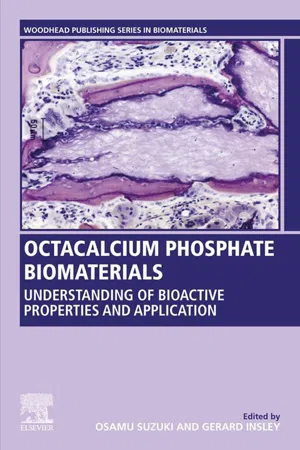
Octacalcium Phosphate Biomaterials
Understanding of Bioactive Properties and Application
- 374 pages
- English
- ePUB (mobile friendly)
- Available on iOS & Android
Octacalcium Phosphate Biomaterials
Understanding of Bioactive Properties and Application
About this book
Octacalcium Phosphate Biomaterials: Past, Present and Future is a comprehensive study of octacalcium phosphate (OCP), a next generation biomaterial for bone regeneration. By focusing both on fundamental research and the use of OCP as a scaffold material, this book explores its potential to deliver improved clinical results. Early chapters in the book discuss OCP's effects on bone cell activity, cellular interactions and their role in bone formation, repair and replacement. Later chapters cover topics such as drug delivery, synthesis methodologies and future analysis techniques. This will be an invaluable and unique resource for researchers, clinicians, students and industrialists in the area of orthopedics and dentistry.OCP is known to be a pre-cursor to hydroxyapatite in the human biomineralization process that forms bone and tooth enamel. Research studies that have emerged in recent years suggest OCP's tremendous potential as a bioactive material.- Contains comprehensive, up-to-date information on the basic science, including physical, chemical and biological properties- Presents the clinical potential of octacalcium phosphate biomaterials- Provides a reference point for new research and increased activity in the area of next generation smarter biomaterials for hard tissue repair and regeneration
Frequently asked questions
- Essential is ideal for learners and professionals who enjoy exploring a wide range of subjects. Access the Essential Library with 800,000+ trusted titles and best-sellers across business, personal growth, and the humanities. Includes unlimited reading time and Standard Read Aloud voice.
- Complete: Perfect for advanced learners and researchers needing full, unrestricted access. Unlock 1.4M+ books across hundreds of subjects, including academic and specialized titles. The Complete Plan also includes advanced features like Premium Read Aloud and Research Assistant.
Please note we cannot support devices running on iOS 13 and Android 7 or earlier. Learn more about using the app.
Information
Evolution of octacalcium phosphate biomaterials
Abstract
Keywords
1.1 Introduction
1.2 Selection of suitable materials to promote bone tissue repair
1.2.1 Octacalcium phosphate: materials science and relevance for biomaterials
1.3 Major findings and advances
1.3.1 Hypothesis and experimental support for the biological significance of octacalcium phosphate
1.3.2 Initial evidence that octacalcium phosphate provides a nucleation site for bone deposition
Table of contents
- Cover image
- Title page
- Table of Contents
- Copyright
- List of contributors
- About the editors
- Preface
- 1. Evolution of octacalcium phosphate biomaterials
- 2. Octacalcium phosphate effects on the systemic and local factors that regulate bone-cell activity
- 3. Functionalization of octacalcium phosphate for bone replacement
- 4. The influence of sterilization on octacalcium phosphate for clinical applications
- 5. Bioactivity and effect of bone formation for octacalcium phosphate ceramics
- 6. Novel scaffold composites containing octacalcium phosphate and their role in bone repair
- 7. Synthesis methodologies options for large-scale manufacturer of octacalcium phosphate
- 8. Synthesis and physical chemical characterizations of octacalcium phosphate–based biomaterials for hard-tissue regeneration
- 9. Calcium orthophosphate (CaPO4)–based bone-graft substitutes and the special roles of octacalcium phosphate materials
- 10. Development and clinical application of octacalcium phosphate/collagen composites
- 11. Modification of octacalcium phosphate growth by enamel proteins, fluoride, and substrate materials and influence of morphology on the performance of octacalcium phosphate biomaterials
- Index